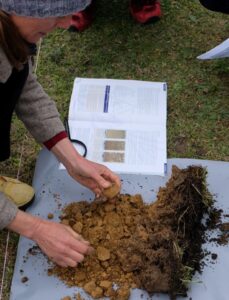Soil4Climate breaks new ground in Wellington
About Soil4Climate

Jessica Barnes and Jenny Lux mixing soil samples at the Soil4Climate launch.
We’re excited to be underway at two sites. We have begun at Tapu-te-ranga marae in Island Bay and at For the Better Good’s Porirua ‘Edible Earth’ farm (in partnership with WELLFed). We’ve started by bench-marking the current health of the soil at both sites. Over the coming year we will watch as the soil is built up through organic growing methods.
Next we are going to grow the project to include test sites around Aotearoa. This will include urban farms, market gardens, pastoral land, schools and backyard gardens.
You can read a bit more about Soil4Climate here.
We firmly believe that organic growing methods are crucial to mitigating climate change.
So how does it work?
We’re using three sets of measurements to test for carbon and other nutrients in soil health:
- The Visual Soil Assessment – which is a hands-on observation of different aspects of the soil. We record how the soil looks, its colour, smell, structure and even the number of earthworms – that bit was great fun!
- The soil Microbiometer – here we are measuring the microscopic life in the soil. We know this is vital for plant health and biodiversity. We are looking at microbial and fungal biomass, and working out the fungal to bacteria ratio.
- Laboratory analysis of soil content – we send samples to recognized laboratories who analyse the soil. We are measuring things like mineral elements and the carbon content.
Soil4Climate’s initial results will be compared with repeat tests done over time. We expect soil health to improve as we grow on the land and change it’s soil composition through organics.
At the same time we are supporting community growers to connect with each other. This project will support us all to learn new things. And of course we are growing nutritious healthy local kai to sustain community.

Jessica Barnes shows us the composting system at For the Better Good’s Porirua ‘Edible Earth’ farm in partnership with WELLfed.




